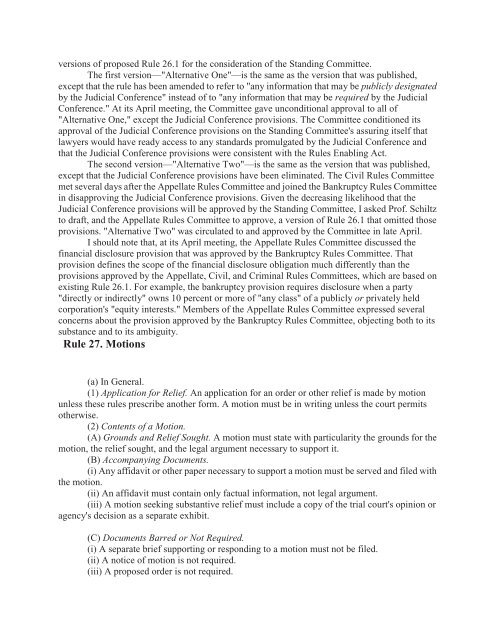Federal Rules of Appellate Procedure 2014-2015, 2014a
Federal Rules of Appellate Procedure 2014-2015, 2014a
Federal Rules of Appellate Procedure 2014-2015, 2014a
Create successful ePaper yourself
Turn your PDF publications into a flip-book with our unique Google optimized e-Paper software.
versions <strong>of</strong> proposed Rule 26.1 for the consideration <strong>of</strong> the Standing Committee.<br />
The first version—"Alternative One"—is the same as the version that was published,<br />
except that the rule has been amended to refer to "any information that may be publicly designated<br />
by the Judicial Conference" instead <strong>of</strong> to "any information that may be required by the Judicial<br />
Conference." At its April meeting, the Committee gave unconditional approval to all <strong>of</strong><br />
"Alternative One," except the Judicial Conference provisions. The Committee conditioned its<br />
approval <strong>of</strong> the Judicial Conference provisions on the Standing Committee's assuring itself that<br />
lawyers would have ready access to any standards promulgated by the Judicial Conference and<br />
that the Judicial Conference provisions were consistent with the <strong>Rules</strong> Enabling Act.<br />
The second version—"Alternative Two"—is the same as the version that was published,<br />
except that the Judicial Conference provisions have been eliminated. The Civil <strong>Rules</strong> Committee<br />
met several days after the <strong>Appellate</strong> <strong>Rules</strong> Committee and joined the Bankruptcy <strong>Rules</strong> Committee<br />
in disapproving the Judicial Conference provisions. Given the decreasing likelihood that the<br />
Judicial Conference provisions will be approved by the Standing Committee, I asked Pr<strong>of</strong>. Schiltz<br />
to draft, and the <strong>Appellate</strong> <strong>Rules</strong> Committee to approve, a version <strong>of</strong> Rule 26.1 that omitted those<br />
provisions. "Alternative Two" was circulated to and approved by the Committee in late April.<br />
I should note that, at its April meeting, the <strong>Appellate</strong> <strong>Rules</strong> Committee discussed the<br />
financial disclosure provision that was approved by the Bankruptcy <strong>Rules</strong> Committee. That<br />
provision defines the scope <strong>of</strong> the financial disclosure obligation much differently than the<br />
provisions approved by the <strong>Appellate</strong>, Civil, and Criminal <strong>Rules</strong> Committees, which are based on<br />
existing Rule 26.1. For example, the bankruptcy provision requires disclosure when a party<br />
"directly or indirectly" owns 10 percent or more <strong>of</strong> "any class" <strong>of</strong> a publicly or privately held<br />
corporation's "equity interests." Members <strong>of</strong> the <strong>Appellate</strong> <strong>Rules</strong> Committee expressed several<br />
concerns about the provision approved by the Bankruptcy <strong>Rules</strong> Committee, objecting both to its<br />
substance and to its ambiguity.<br />
Rule 27. Motions<br />
(a) In General.<br />
(1) Application for Relief. An application for an order or other relief is made by motion<br />
unless these rules prescribe another form. A motion must be in writing unless the court permits<br />
otherwise.<br />
(2) Contents <strong>of</strong> a Motion.<br />
(A) Grounds and Relief Sought. A motion must state with particularity the grounds for the<br />
motion, the relief sought, and the legal argument necessary to support it.<br />
(B) Accompanying Documents.<br />
(i) Any affidavit or other paper necessary to support a motion must be served and filed with<br />
the motion.<br />
(ii) An affidavit must contain only factual information, not legal argument.<br />
(iii) A motion seeking substantive relief must include a copy <strong>of</strong> the trial court's opinion or<br />
agency's decision as a separate exhibit.<br />
(C) Documents Barred or Not Required.<br />
(i) A separate brief supporting or responding to a motion must not be filed.<br />
(ii) A notice <strong>of</strong> motion is not required.<br />
(iii) A proposed order is not required.


















